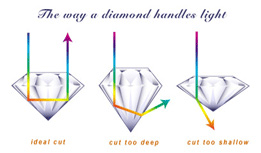The easiest - and most obvious - thing to do is to simply ask for a certificate. Many topnotch diamond companies keep very good track of their diamonds and have certificates of authenticity for them. For those that don't issue certificates, many independent jewelry appraisers can issue certification of authenticity for rings and other such jewelry. While this is a good method if available, many rings still do not have certificates. Typically only top-tier diamonds come with certificates. Other, more cheaper diamonds, often lack a certificate despite their authenticity.
The second easiest method is to simply look at the diamond! It may seem intimidating to look at a diamond and check for its authenticity, but it really does not take an expert in most cases. A key characteristic of diamonds is how the refract light. This means that if you look at something through a diamond it should appear highly distorted. For example, if you look at a newspaper or some other print through a diamond you should be able to see it; otherwise it is not a diamond. The drawback with this method is that while you can tell that the diamond is real, you don't know it is of a high quality.
 |
This diagram illustrates the concept of refraction and why this neat little trick works for diamonds.
This next method is the simplest to perform, but it is probably not feasible for a lot of people. There are devices known as diamond or moissanite testers. These devices do exactly as their names suggest - they test for the authenticity of diamonds. They work wonderfully, but they can be a little pricey to purchase. The price often does not justify how much use one can get out of one of these devices unless they frequently check the authenticity of diamonds.
One of the cooler features of a diamond is how it will glow blue under an ultraviolet light. Simply get an ultraviolet lamp and let it shine light onto a diamond. If it turns blue, then it is a diamond. Unfortunately, this method is not completely effective either. Higher quality diamonds often do not turn blue under ulttraviolet lights. While this can't absolutely confirm a diamond is real, it can confirm that a diamond is fake. Many fake gems will turn different, non-blue colors under the light, so if it turns grey, yellow, or some other color then it is most definitely not a diamond.
I hope this short little guide has been helpful to you. Nothing is worse than spending exorbitant amounts of money on something and finding out it is fake. Hopefully, you will never be duped by fake diamond rings again after reading this guide.